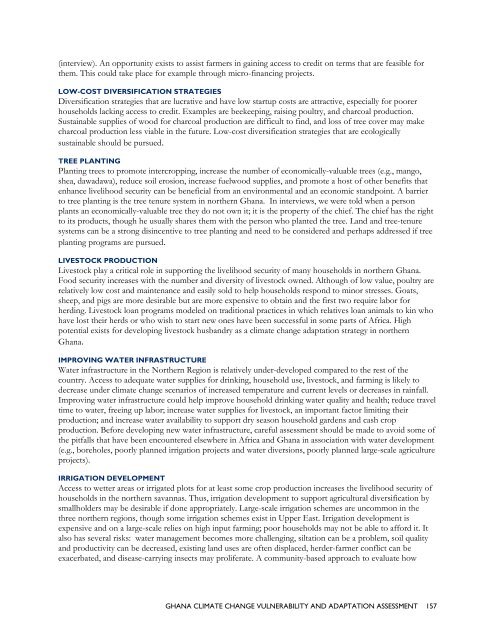ghana climate change vulnerability and adaptation assessment
ghana climate change vulnerability and adaptation assessment
ghana climate change vulnerability and adaptation assessment
- No tags were found...
You also want an ePaper? Increase the reach of your titles
YUMPU automatically turns print PDFs into web optimized ePapers that Google loves.
(interview). An opportunity exists to assist farmers in gaining access to credit on terms that are feasible forthem. This could take place for example through micro-financing projects.LOW-COST DIVERSIFICATION STRATEGIESDiversification strategies that are lucrative <strong>and</strong> have low startup costs are attractive, especially for poorerhouseholds lacking access to credit. Examples are beekeeping, raising poultry, <strong>and</strong> charcoal production.Sustainable supplies of wood for charcoal production are difficult to find, <strong>and</strong> loss of tree cover may makecharcoal production less viable in the future. Low-cost diversification strategies that are ecologicallysustainable should be pursued.TREE PLANTINGPlanting trees to promote intercropping, increase the number of economically-valuable trees (e.g., mango,shea, dawadawa), reduce soil erosion, increase fuelwood supplies, <strong>and</strong> promote a host of other benefits thatenhance livelihood security can be beneficial from an environmental <strong>and</strong> an economic st<strong>and</strong>point. A barrierto tree planting is the tree tenure system in northern Ghana. In interviews, we were told when a personplants an economically-valuable tree they do not own it; it is the property of the chief. The chief has the rightto its products, though he usually shares them with the person who planted the tree. L<strong>and</strong> <strong>and</strong> tree-tenuresystems can be a strong disincentive to tree planting <strong>and</strong> need to be considered <strong>and</strong> perhaps addressed if treeplanting programs are pursued.LIVESTOCK PRODUCTIONLivestock play a critical role in supporting the livelihood security of many households in northern Ghana.Food security increases with the number <strong>and</strong> diversity of livestock owned. Although of low value, poultry arerelatively low cost <strong>and</strong> maintenance <strong>and</strong> easily sold to help households respond to minor stresses. Goats,sheep, <strong>and</strong> pigs are more desirable but are more expensive to obtain <strong>and</strong> the first two require labor forherding. Livestock loan programs modeled on traditional practices in which relatives loan animals to kin whohave lost their herds or who wish to start new ones have been successful in some parts of Africa. Highpotential exists for developing livestock husb<strong>and</strong>ry as a <strong>climate</strong> <strong>change</strong> <strong>adaptation</strong> strategy in northernGhana.IMPROVING WATER INFRASTRUCTUREWater infrastructure in the Northern Region is relatively under-developed compared to the rest of thecountry. Access to adequate water supplies for drinking, household use, livestock, <strong>and</strong> farming is likely todecrease under <strong>climate</strong> <strong>change</strong> scenarios of increased temperature <strong>and</strong> current levels or decreases in rainfall.Improving water infrastructure could help improve household drinking water quality <strong>and</strong> health; reduce traveltime to water, freeing up labor; increase water supplies for livestock, an important factor limiting theirproduction; <strong>and</strong> increase water availability to support dry season household gardens <strong>and</strong> cash cropproduction. Before developing new water infrastructure, careful <strong>assessment</strong> should be made to avoid some ofthe pitfalls that have been encountered elsewhere in Africa <strong>and</strong> Ghana in association with water development(e.g., boreholes, poorly planned irrigation projects <strong>and</strong> water diversions, poorly planned large-scale agricultureprojects).IRRIGATION DEVELOPMENTAccess to wetter areas or irrigated plots for at least some crop production increases the livelihood security ofhouseholds in the northern savannas. Thus, irrigation development to support agricultural diversification bysmallholders may be desirable if done appropriately. Large-scale irrigation schemes are uncommon in thethree northern regions, though some irrigation schemes exist in Upper East. Irrigation development isexpensive <strong>and</strong> on a large-scale relies on high input farming; poor households may not be able to afford it. Italso has several risks: water management becomes more challenging, siltation can be a problem, soil quality<strong>and</strong> productivity can be decreased, existing l<strong>and</strong> uses are often displaced, herder-farmer conflict can beexacerbated, <strong>and</strong> disease-carrying insects may proliferate. A community-based approach to evaluate howGHANA CLIMATE CHANGE VULNERABILITY AND ADAPTATION ASSESSMENT 157
















